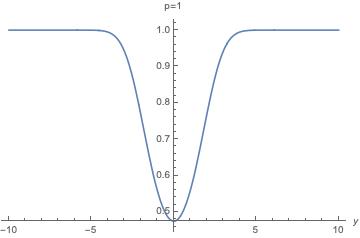I would like to ask a follow up on a question I asked some days ago.
Consider the function
$$f_{n}(x)=e^{-x^2}x^n.$$
and the function
$$h_p(x):=e^{-\vert x \vert^p}.$$
My goal then was to analyze
$$ F_2(y):=\frac{(f_2*h_2)(y)}{(f_0*h_2)(y)}- \left(\frac{(f_1*h_2)(y) }{(f_0*h_2)(y)}\right)^2$$
and Iosif Pinelis showed that this expression is constant.
Now instead of convolving with $e^{-x^2}$ one could convolve with a function that decays slower than $e^{-x^2}$ for example $e^{-\vert x \vert}.$ That is, we then get
$$ F_1(y):=\frac{(f_2*h_1)(y)}{(f_0*h_1)(y)}- \left(\frac{(f_1*h_1)(y) }{(f_0*h_1)(y)}\right)^2.$$
Mathematica shows that $F_1$ is now not at all constant but has a unique maximum at $0$ and decreases from there.
On the other hand one can consider the faster decaying function $e^{-x^4}$ and consider
$$ F_4(y):=\frac{(f_2*h_4)(y)}{(f_0*h_4)(y)}- \left(\frac{(f_1*h_4)(y) }{(f_0*h_4)(y)}\right)^2.$$
In this case, the function has a unique minimum at $y=0$ and increases from there.
Question: Can we show that $F_p$ has a global maximum at zero for $p>2$ and a global minimum at zero for $p<2$?
Further observations:
All functions $F_p$ are positive by the Cauchy-Schwarz inequality.
So to summarize for
medium decay-$F_2$ is a constant function.
fast decay - $F_4$ has a unique maximum (Fig. 2).
I also checked the function $e^{-\vert x \vert^{2+10^{-4}}}$, i.e. with an exponent slightly above $2$
and it seems the function has the expected behaviour, i.e. there exists a unique maximum at zero and the function decays from there.
One sees the opposite effect by convolving with $e^{-\vert x \vert^{2-10^{-4}}}.$
Addendum:
I also checked for log-convexity/log-concavity. Apparently, the functions $F_p$ are not log-convex or log-concave in general.
And finally, I computed the first derivative for convolving with $e^{-\vert x \vert^p}$ at $p=2$ by numerically differentiating





